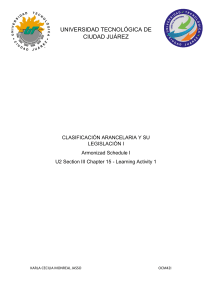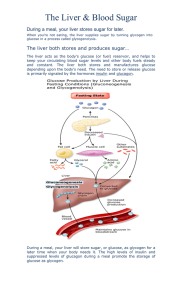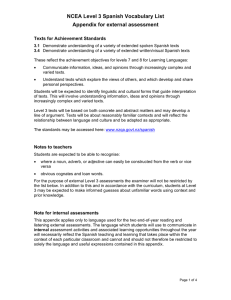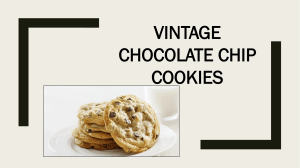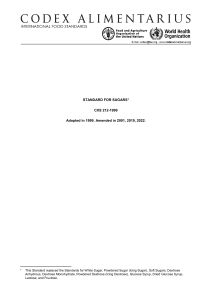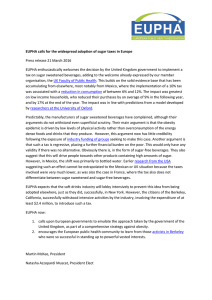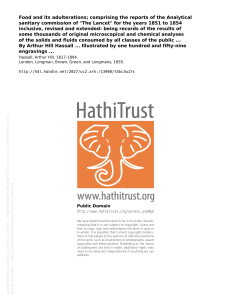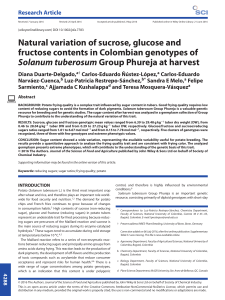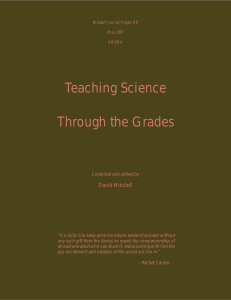Reading into Writing - Trinity College London
Anuncio
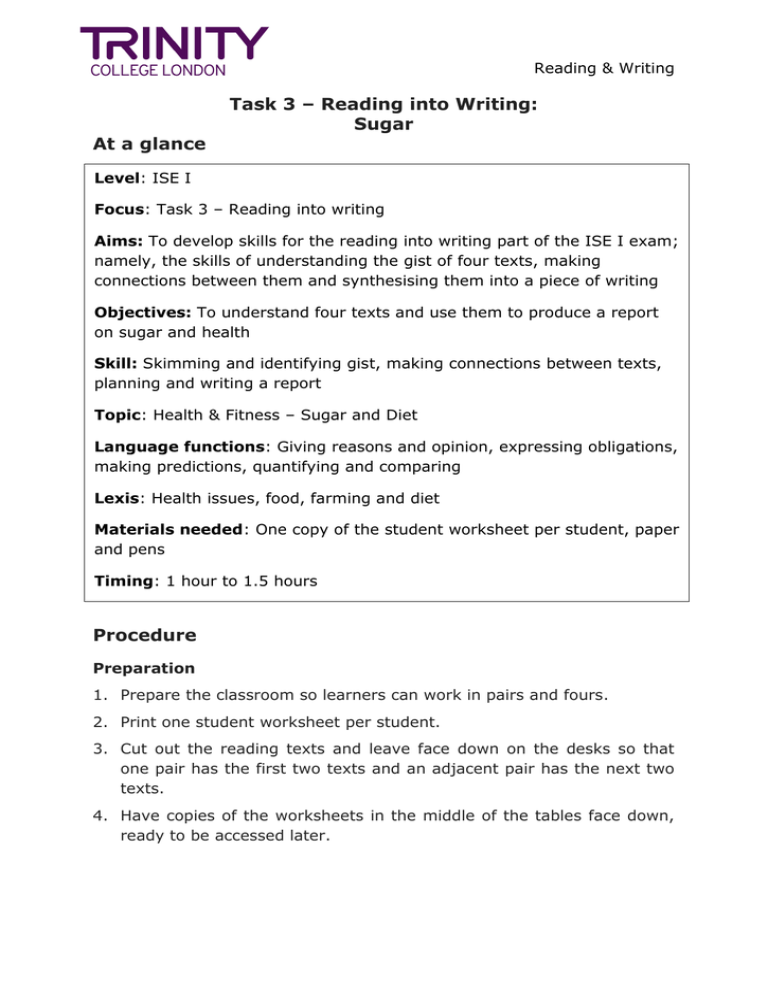
Reading & Writing Task 3 – Reading into Writing: Sugar At a glance Level: ISE I Focus: Task 3 – Reading into writing Aims: To develop skills for the reading into writing part of the ISE I exam; namely, the skills of understanding the gist of four texts, making connections between them and synthesising them into a piece of writing Objectives: To understand four texts and use them to produce a report on sugar and health Skill: Skimming and identifying gist, making connections between texts, planning and writing a report Topic: Health & Fitness – Sugar and Diet Language functions: Giving reasons and opinion, expressing obligations, making predictions, quantifying and comparing Lexis: Health issues, food, farming and diet Materials needed: One copy of the student worksheet per student, paper and pens Timing: 1 hour to 1.5 hours Procedure Preparation 1. Prepare the classroom so learners can work in pairs and fours. 2. Print one student worksheet per student. 3. Cut out the reading texts and leave face down on the desks so that one pair has the first two texts and an adjacent pair has the next two texts. 4. Have copies of the worksheets in the middle of the tables face down, ready to be accessed later. Reading & Writing In class 1. Start the class by telling the students that they will look at skills needed for ISE I Task 3 - Reading into writing. Ask learners what they know about Task 3 of the ISE Reading & Writing exam. 2. In pairs, get the learners to ask their partner: “How much sugar do you think you eat every day?” 3. Split the class into two halves, A and B. Write the four words for each group on the board (see table below) and ask them if they know their meaning – if not – allow them to use the resources available to look them up (dictionaries, phones if allowed, etc.). Nominate one learner from A to define one of the words. Then that learner peer nominates someone from the other side to define a word and to nominate the next person. A B companies (n.) tax (n.) responsible (adj.) obesity (n.) packets (n.) blood pressure (n.) blame (v.) diet (n.) (n.b. alternatively, if you are worried about not having sufficient time for the reading/writing, you could simply pre-teach whichever words from the list you feel that students won‟t be aware of) 4. Ask learners in their pairs to turn over their two texts on the table and spend five to ten minutes reading and discussing them. 5. Ask the students in their pairs to get together with a different pair (a pair that discussed a different text to theirs). Ask them, as a four, to look at Task A on their worksheets and to correct the information also identifying which text allowed them to correct it. This should not only help them identify the gist of each text but is also relevant practice for the true or false aspect of tasks 1 & 2 in the ISE Reading & Writing exam. 6. Check answers in open-class. 7. Now ask the students in their groups to complete Task B, where they must identify which two texts provide them with the information given. This allows them to continue sharing information from the texts as well as encouraging them to make connections between them – a skill required for Task 3 of the ISE Reading & Writing exam. Reading & Writing 8. Check answers in open-class. 9. Inform the learners that they are now going to write a report. Ask them what they know about report writing for ISE: How many words should it have? How should it be organised (in paragraphs)? What style should it have – formal or informal? Also, bring to their attention the need to use modals or semi-modals such as „must‟, „have to‟, „need to‟, „will‟ and „might‟ to express obligation and possibility. 10. Instruct the learners that they are now going to use the information from the texts to write a report that: 1) explains why the amount of sugar we eat is important 2) gives their opinion on the best way to control the sugar in our diet 11. Ask the students to return to their original pairs to complete Task C (the report planner). They should identify three ideas from three of the different texts to answer each part of the question. Direct the students to Task C where their ideas can be written in the designated boxes. They can then make notes in the central box as to how to help them organise their paragraphs. This training should be transferrable to the exam; it encourages them to make more effective notes for planning Task 3 answers. Therefore, learners should compare their notes with other pairs and discuss them. 12. Whilst the learners are writing their report plans, monitor and give feedback where necessary. 13. Now ask the learners to write their report on a fresh piece of paper – it should be between 100 and 130 words long and to spend no longer than 30 minutes on it. Ask them to continue working in their pairs, helping and checking each other, and to write one paragraph each. Bring to their attention the need to use modals or semi-modals such as „must‟, „have to‟, „need to‟, „will‟ and „might‟ to express obligation and possibility. 14. (Optional). When finished, learners may display their reports on the walls of the classroom. The class can then move around the class, reading and possibly leaving comments on each other‟s reports. Reading & Writing Extension activity 1. If the class has odd numbers, a more advanced student may work on their own with two texts rather than in a pair. Also, if the class does not split into fours, a more advanced pair could have all four texts. 2. Any advanced pairs that finish early could be asked to check the work of other pairs; in particular supporting them with any sentence structure errors. 3. Early finishers could be asked to write an extension paragraph on how diet has changed in recent years and/or will change in the future. Further support activity 1. Lower level learners could be paired with a stronger, supportive partner and could focus on the shorter texts (the second and fourth) in their pairs. If they are slower at writing, they could write just the first and last sentences of each paragraph, while their partner writes the rest. 2. Alternatively, slower pairs could be asked just to complete the second reading exercise (which two texts…). Rather than writing a full report, they could be asked to note down key ideas from the texts and to write three sentences for each part of the prompt. After class Ask learners to look at the amount of sugar in the food they eat over a day. They could then try eating half the amount of sugar they usually have one day. Then, write a diary about how they felt about this and any surprises. Reading & Writing Student Worksheet: Task 3 – Reading into Writing: Report on Sugar Please cut out the following to make four separate texts A The history of sugar started thousands of years ago in Southeast Asia. It was in India that people first discovered how to get the pure sugar juice out of the plant. People from all over Asia visited the country to find out more about this process. These included explorers from Spain and the Arab world. They brought sugar to Europe from the 12th century onwards. The Portuguese first took sugar to the Americas in the 15th century. Soon, the Caribbean became the largest growers of sugar. By the 18th century, sugar was very popular in Europe. Jam, candy, biscuits, tea and coffee became common foods. In the 20th century, farmers in America started making fructose syrup from corn. This is used in a lot of soft drinks and food. It became very important for farming in America but some people are worried about the health effects. B Rosa I think we eat too much sugar. People don‟t know how much they eat. Food companies must put more information on packets. Miguel You can‟t always blame the companies. People need to be more responsible about their diets. They need to have less candies, biscuits and soft drinks. Ingrid I think it is not easy for people to control their diets and eat less sugar. Governments must do more – they must make rules so companies have to put less sugar in food and drinks. Reading & Writing C D In 1971, a scientist called John Yudkin wrote a book called „Pure, White and Deadly‟ about the negative effects of sugar. Many people disagreed with him at the time but, now, a group of health experts and academics have come together to start a group called “Action Against Sugar”. In England, one in four people have problems with their health and weight and scientists are worried that sugar is a big part of this. They believe this will get worse in the future. Even foods such as soups and yoghurts, which we think are healthier choices, can have a lot of sugar in them. They want governments to stop companies from advertising foods with a lot of sugar in them. They say that sugar - rather than fat - is the big problem for people‟s health. According to them, if you eat too much sugar, it will lead to problems like obesity and high blood pressure. One possible answer is a tax on sugary foods to make them more expensive. But some people think this will make things worse for poorer people. Also, a lot of farming companies are angry because sugar is so important for their business. Reading & Writing Task A: Correct these sentences: 1. The amount of sugar people in America eat has gone up a little bit in 200 years. (Which text? _____) 2. People have the same opinion on the question „Are governments or people responsible for the amount of sugar we eat?‟ (Which text? _____) 3. A group of scientists have started a group which talks about the health problems which can come from fat. (Which text? _____) 4. Growing and eating sugar is quite modern – we‟ve done it for about 100 years. (Which text? _____) Task B: Which two texts give you the following ideas? 1. Sugar from corn is very important for American farming so they don‟t want new rules around sugar in food. (Texts _____ & __________) 2. Sugar has been popular for centuries but we‟ve eaten more and more since the 18th century. (Texts _____ & __________) 3. There are some rules governments could make – about adverts, putting less sugar in food and taxes. (Texts _____ & __________) Reading & Writing Task C: Make notes in the boxes to plan your report Idea from text ___ Notes for “Explain why the amount of sugar we eat is important” Idea from text ___ Idea from text ___ Notes for “Give your opinion on the best way to control sugar in your diet” Idea from text ___ Idea from text ___ Idea from text ___ Reading & Writing Answer Key: Task A: Correct these sentences: 1. The amount of sugar people in America eat has gone up a lot in 200 years. (Which text? D) 2. People have different opinions on the question „Are governments or people responsible for the amount of sugar we eat?‟ (Which text? B) 3. A group of scientists have started a group which talks about the health problems which can come from sugar. (Which text? C) 4. Growing and eating sugar is very old – we‟ve done it for thousands of years. (Which text? A) Task B: Which two texts give you the following ideas? 1. Sugar from corn is very important for American farming so they don‟t want new rules around sugar in food. (Texts A & C) 2. Sugar has been popular for centuries but we‟ve eaten more and more since the 18th century. (Texts A & D) 3. There are some rules governments could make – about adverts, putting less sugar in food and taxes. (Texts B & C) Reading & Writing Task C: Make notes in the boxes to plan your report (Sample answer) Idea from text A: We have eaten sugar for thousands of years Idea from text C: Notes for “Explain why the amount of sugar we eat is important” Sugar = very old, started 1,000s years ago Idea from text D: We eat a lot more sugar nowadays Became popular 200 yrs ago Now, we eat a lot–15lb/year > 130lb Health probs. – obesity, blood pressure Sugar can lead to health problems Idea from text A: Sugar is very important for farmers Notes for “Give your opinion on the best way to control sugar in your diet” Idea from text C: Put a tax on sugar Put a tax? Sugar = very important for farmers Hurt business Idea from text B: Best way = personal responsibility, look at packets Be more responsible and look at packets Original Sources Text A adapted from http://en.wikipedia.org/wiki/History_of_sugar Texts B & C adapted from http://www.independent.co.uk/life-style/health-and-families/health-news/issugar-the-new-evil-arguments-for-and-against-the-grain-9171543.html http://www.dailymail.co.uk/home/you/article-2568682/Special-report-Sugarbitter-truth.html Text D adapted from http://www.richmondinstitute.com/u-s-consumption-of-sugar-a-not-so-sweetreality
